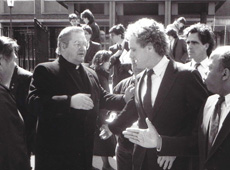Commemorating the Rising has always been different in the north
Posted By: April 25, 2016
Alison Martin Irish News (Belfast). Monday, April 25, 201
Alison Martin holds a BA in Modern History and an MA in Irish History
In recent weeks, the media have focused on how the 100th anniversary of the Easter Rising has been commemorated in Dublin.
But events to mark the Rising have also taken place in other cities, including Belfast.
According to an account re-published in the Republican News in 1973, a small commemoration took place in Belfast to mark the first anniversary of the Rising.
Two of the Rising leaders had associations with Belfast, including James Connolly who lived on the Falls Road and was the Belfast organiser of Jim Larkin’s Irish Transport and General Workers Union.
Seán MacDermott, though born in Leitrim, spent some time living in Butler Street, Ardoyne whilst working as a tram conductor.
On Easter Sunday 1917, a party of around 150 men gathered in Divis Street and marched to Clonard
Monastery for an anniversary Mass.
According to the witness, ‘no bands played, no emblems were worn and no banners were carried.’ Admittedly, this may be a slightly romanticised account.
However, this commemoration certainly appeared less chaotic than its counterpart in Dublin, where the first anniversary of the Rising was marked by a riot.
A tricolour was hoisted over the ruined GPO and another over Nelson’s pillar and police were stoned by inner-city youths when they tried to saw down the flagpole.
Over the next few years, a number of developments took place in Ireland which changed the political landscape.
Nearly two years into the War of Independence, Lloyd George passed the 1920 Government of Ireland Act, which partitioned Ireland into the six counties of Northern Ireland and the 26 counties of southern Ireland.
Of particular significance to both parts of the island was the Anglo-Irish Treaty, which established the Irish Free State.
It also contained a clause allowing Northern Ireland to opt out of the Free State, which it did.
In the years after the Irish Civil War, Rising commemorations in The North were fairly low key in comparison to more established events, such as the Wolfe Tone commemoration at Cavehill.
Nevertheless, as a result of comments made at past events, individual Easter commemorations were banned but this did little to deter participants and commemorations frequently became the scene of confrontation between republicans and police.
Despite the ban on certain 1916 commemorations, the northern government could not prevent a
religious ceremony being held and the Belfast IRA used this to parade to the gates of Milltown, usually guarded or locked by the RUC.
At the gates, a senior IRA figure would usually kneel down and say the Rosary, which became a hallmark of the Belfast commemorations in the 1930s.
In 1935, it was reported around 2,000 republicans gathered at the cemetery gates –- the largest attendance at an Easter Rising commemoration in Belfast to date.
But in 1937 an illegal commemoration led to RUC baton charges and stone-throwing from the crowds.
On Easter Sunday 1943, armed IRA men told an audience at the Broadway Cinema on the Falls Road to return to their seats as Hugh McAteer and Jimmy Steele, two leaders of the Northern command, took to the stage.
Steele read out the 1916 Proclamation and McAteer read an Army Council statement followed by a two minute silence for those who had died for Ireland.
There were clear parallels between this public reading of the proclamation during wartime and the original reading of the proclamation in Dublin in 1916.
Interestingly, the Irish Times reported no commemoration was held in Belfast, while the Irish News reported enthusiastically on proceedings.
To mark the 50th anniversary of the Rising, events were held in both the Republic and Northern Ireland, differing in setting and nature. In Belfast, republicans and the GAA played a major role in their organisation.
The signature event on the April 17 saw 70,000 people watch a large parade from the Falls Road to Casement Park.
The most vocal opponent of the commemorations was Ian Paisley, who led a service at the Ulster Hall to give thanks for the defeat of the Rising.
Afterwards, rival republican and loyalist parades almost collided on Hamill Street.
After the outbreak of the Troubles, the southern state cancelled all public military commemorations of 1916.
During the 1970s, a typical 1916 commemoration in Belfast involved British helicopters flying low overhead whilst the RUC watched the Easter parades from a discrete distance.
During the 1980s and 1990s, commemorations of the Rising were largely left to militant republican groups.
Some attempts were made to ban or restrict republican Easter parades in the north, but were often unsuccessful.
In Belfast, the centenary of the Rising has been marked by a number of talks, plays and exhibitions.
After decades of conflict, it’s still difficult for certain sections of the community not to draw parallels between 1916 and more recent
Troubles.
Therefore, attempts have been made to reflect upon our shared history such as City Hall’s ‘Reflections on 1916’ exhibition examining key events in Ireland’s history – the Rising, the Battle of the Somme and the Battle of Jutland and the impact on the lives of local people.
Other commemorative events, however, were more politicised, including an illegal parade in Coalisland involving men in paramilitary-style uniform.
But there are signs of progress such as First Minister Arlene Foster attending a Church of Ireland event in Dublin where leading historians discussed the Rising.
This move was generally lauded as a step right direction with regards to the reconciliation process.
It will be interesting to see how the north deals with other important anniversaries such as the centenary of Northern Ireland’s creation as a legal entity in 2021.
Alison Martin holds a BA in Modern History and an MA in Irish History from Queen’s University Belfast










